Fox Live Valve Neo Electronic Shocks
Sizes Offered:
Metric:
- 210 x 47.5 / 50 / 52.5 / 55 mm
- 230 x 57.5 / 60 / 62.5 / 65 mm
- 250 x 67.5 / 70 / 72.5 / 75 mm
Metric Trunnion:
- 185 x 47.5 / 50 / 52.5 / 55 mm
- 205 x 57.5 / 60 / 62.5 / 65 mm
- 225 x 67.5 / 70 / 72.5 / 75 mm
[Shocks default to 55, 65 or 75 mm stroke; reducing spacers can be added or removed without major disassembly.]
Stated Weights:
- Float X Live Valve Neo: 689 g (190 x 45 mm)
- DHX Live Valve Neo: 605 g (210 x 55 mm w/o spring)
Blister’s Measured Weight:
- Fox DHX Live Valve Neo shock: 629 g (230 x 60 mm, w/ battery)
- 450 lb/in SLS spring: 310 g
MSRP:
- Live Valve Neo Kit (bump sensors, battery, charger): $399 USD / $534.65 CAD
- Float X Live Valve Neo: $999 USD / $1399 CAD (requires Neo Kit purchased separately)
- DHX Live Valve Neo: $949 USD / $1269 CAD (requires Neo Kit purchased separately)
- Spare Neo battery: $79 USD / $106 CAD
- Spare charger and cable: $49 USD / $69 CAD

Intro
Electronically-controlled mountain bike suspension isn’t a new idea — the K2 Smart Shock came out in the late 1990s (!!) — but Fox was the first major manufacturer to roll it out for the modern era, with their original implementation of Live Valve back in 2018.
That system worked pretty well, but it was expensive, complex, and required wired connections between the fork, shock, sensors, and a control module mounted on the frame. That meant that it worked best on frames that were specifically designed with provisions for all the bits and bobs, and between that limitation and the high cost, there was a ceiling for how widely it would be adopted.
Fox understood that and went back to the drawing board. The end result is “Live Valve Neo” — a dramatically streamlined, wireless version of the system with the same end goal: to firm up your suspension when you want pedaling efficiency, and automatically open it up when needed so that it actually works as suspension. So let’s see how they’ve gone about it.
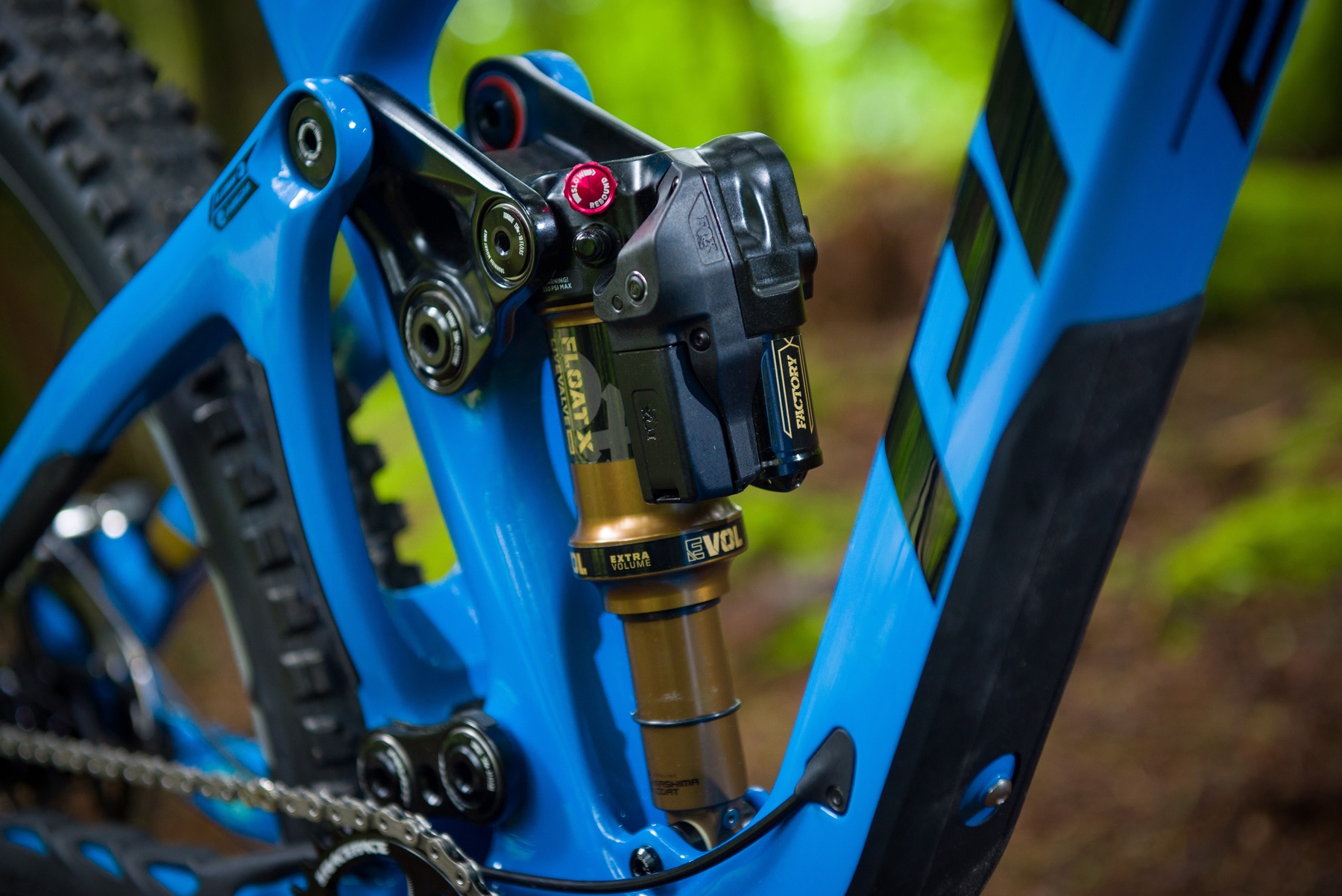
Design & Versions
Fox is starting by offering Live Valve Neo in shock versions built around their Float X and DHX shocks — which are essentially the air- and coil-sprung versions of the same general damper architecture. Both are primarily aimed at all-round Trail bike use, though they’re offered in sizes up to 250 (eyelet) / 225 mm (trunnion) lengths, which are most commonly seen on DH bikes. FWIW, Neko Mulally and the rest of the Frameworks DH team have been spotted racing the DHX Live Valve Neo for a while now.
Fox’s take is that do-it-all Trail bikes are both the biggest segment of the mountain bike market overall, and the category that Live Valve Neo is best suited to, so they’ve started here. They haven’t ruled out an expanded set of Live Valve Neo shocks down the line, but we’ll just have to wait and see on that part.
The Live Valve Neo shocks use a very similar base damper design to the standard Float X and DHX shocks. However, the Live Valve Neo versions effectively replace the manual climb switch with an electronically controlled solenoid valve that toggles between the open mode and the firmer pedaling-platform position. Like the standard versions of the shocks, both get externally adjustable low-speed compression and rebound, but the Live Valve Neo variants add a third knob that controls how firm the pedaling platform is when engaged — think of it as an adjuster for how much force it takes for the pedal mode to blow off and start moving.
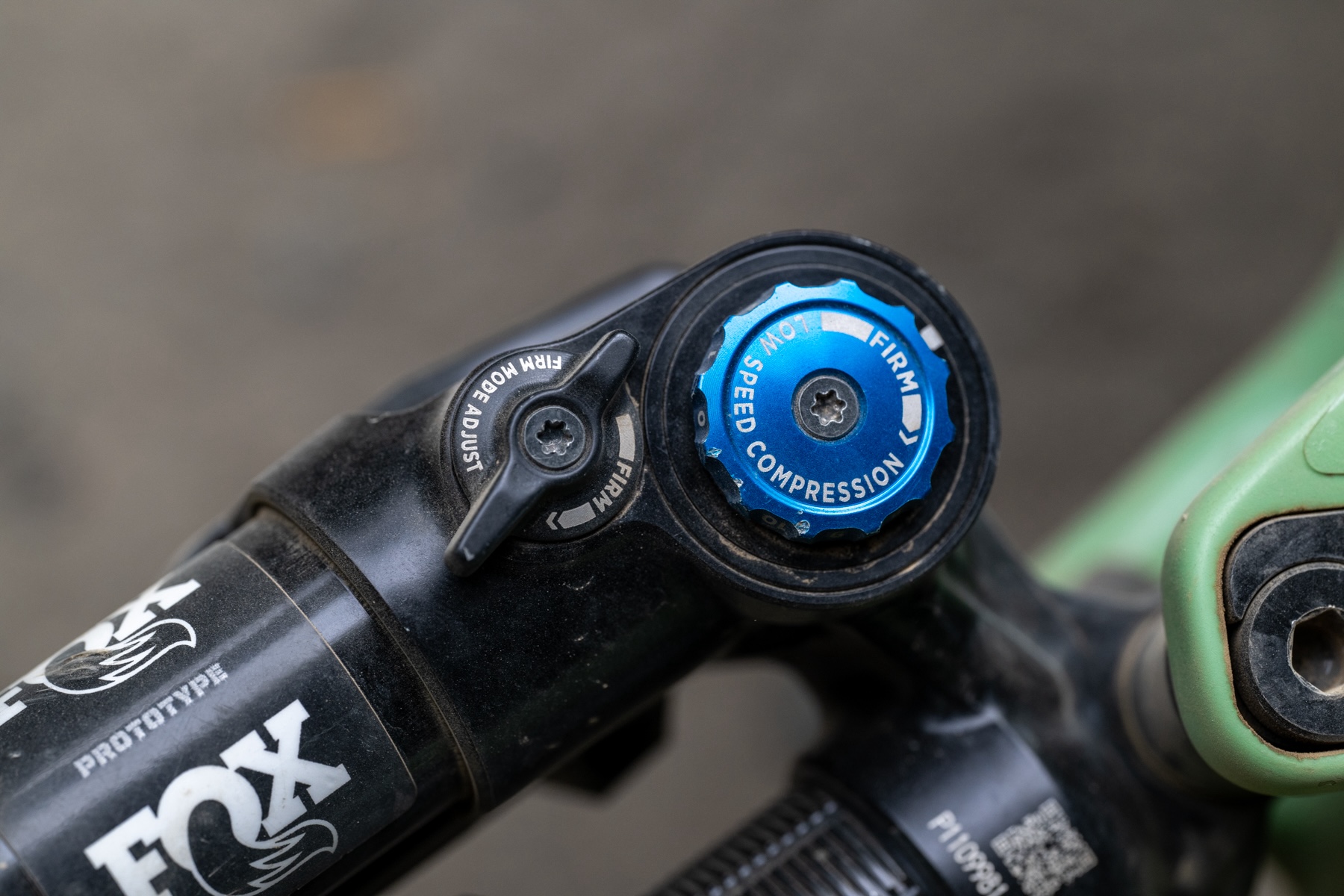
You’ll also notice that we’re only talking about shocks here — in contrast to both the original Live Valve and RockShox’s take on the concept, Flight Attendant, there’s no Live Valve Neo fork option. Fox says that there are a bunch of reasons for going that route, including simplifying things and reducing the overall system cost, and that there’s simply far more to be gained by improving rear suspension efficiency than by adding a platform to the fork.
The way Fox has implemented Live Valve Neo probably plays a role there, too. Like the original version of Live Valve (but in contrast to Flight Attendant), Live Valve Neo defaults to firming up the shock, and opens it when it detects a bump (subject to a variety of highly customizable parameters that we’ll cover in more detail below).
Also unlike Flight Attendant, Live Valve Neo only toggles between two modes — Firm and Open — rather than having a middle-ground “Pedal” mode. I never rode the original version of Live Valve, but a common complaint was that the fork could feel a bit harsh when hitting the first bump after a smooth section before the system could react and open up. By doing away with the electronic controls on the fork, Fox has left a smidge more time for the system to react (since the front wheel encounters a bump before the rear wheel gets there and needs the shock to be open).
Electronics & Batteries
And that brings us to another important update to Live Valve Neo: it’s wireless. The original version of Live Valve used wired connections between the fork, shock, and a frame-mounted control module. With Live Valve Neo, Fox simply uses a sensor that mounts under the forward / upper brake mounting bolt at both the front and rear of the bike to detect bumps and communicate them to the shock.
Fox says the sensors assess terrain inputs 400 times per second. Those sensors use a standard CR2032 battery (the same as used in SRAM’s AXS controllers and a whole lot of other stuff). The Live Valve Neo sensors also communicate to the shock via Fox’s “Neo” wireless protocol that they announced with the Transfer Neo dropper post last month.

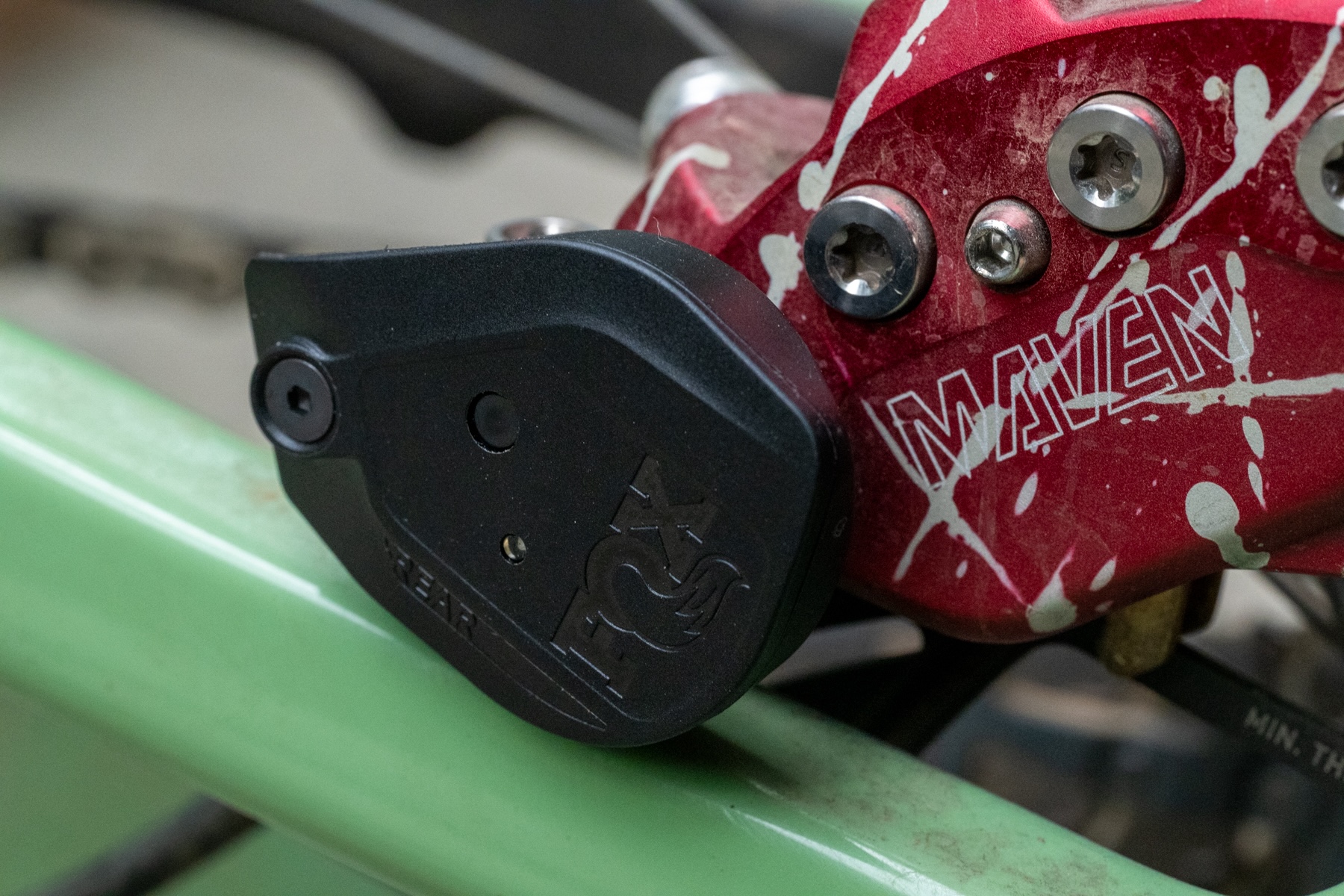
The original version of Live Valve was wired primarily because the existing wireless communication protocols weren’t fast enough to respond to bumps in the way Fox needed. The new Neo system is claimed to take just 3 milliseconds to transmit a signal from the sensor to the shock, which Fox says is about 100 times faster than Bluetooth.
The Live Valve Neo shock uses the same swappable, rechargeable lithium battery as the Transfer Neo, which Fox says is good for 15-20 hours of ride time between charges; the coin cell batteries in the sensors should last at least a year. If one or more of the batteries dies (including the main one on the shock), the system will flip to open mode so that your suspension still works properly; it just won’t engage the climb mode until battery charge is restored.
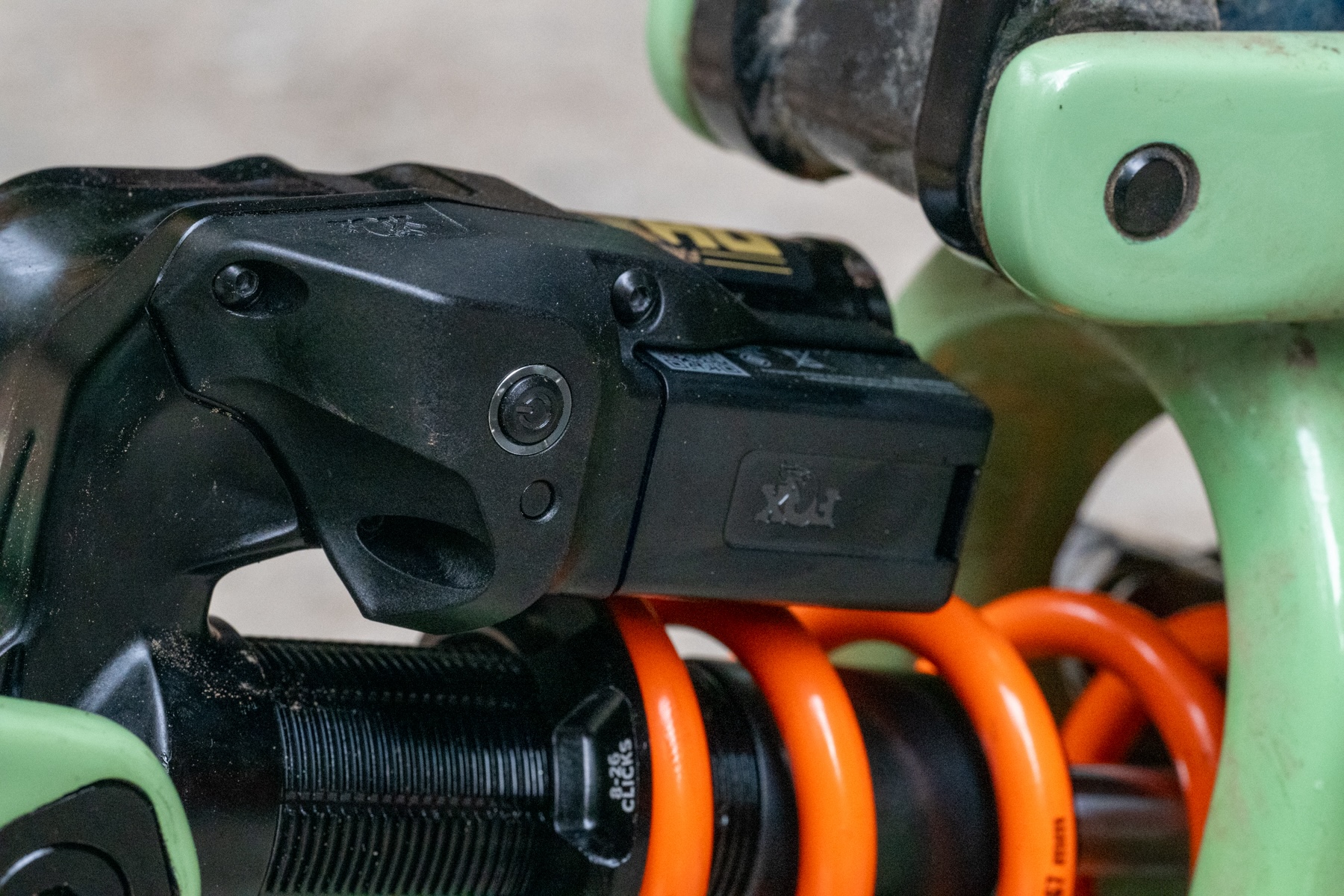
The shock battery charges on a cradle very similar to the SRAM / RockShox AXS charger, and a battery, charger, and USB A to USB C cable for the charger are included with each Live Valve Neo shock. Spare batteries are available for $79 USD / $106 CAD / €76.75 if you need a replacement or want to keep a backup on hand. As with the Transfer Neo dropper, the Live Valve Neo shocks are rated to IPX7 waterproofness, which requires them to survive being submerged in one meter of water for 30 minutes.
Setup & Tuning
Fox’s smartphone app offers a bunch of options for tuning how Live Valve Neo decides when to open up the shock, and when it can leave it in firm mode.
In short, the app allows you to compile a “tune,” meaning a combination of settings for the behavior of the electronics, not a damper tune in the traditional sense; you can toggle through multiple tunes via the app. Fox includes a few baseline ones, but you can customize to your heart’s content from there. The app also allows you to share tunes via a QR code, and Fox says that they’ll continue to build out their library of available tunes as more Live Valve Neo shocks make their way into the world.
A given tune covers a bunch of different parameters. You can set the shock to behave differently depending on whether the bike is pointed uphill, downhill, or on flat ground; that includes setting the angles of inclination that define what counts as “uphill” and “downhill” (e.g., anything over 5° up is uphill and over 7° down is downhill; anything in between is “flat”).
Within each of those three terrain types, you can set the magnitude of a bump that is required to open the shock (measured in acceleration in Gs) from both the front and rear wheels independently. You can also set how long the shock stays open after experiencing a bump in each of the possible combinations as well.
If you’d prefer, you can also set the shock to not respond to bumps at all, and simply remain open or closed in a given state (e.g., always firm uphill and/or always open going downhill). You can also set whether it responds to bumps from both sensors (“coupled” mode) or only the rear one (“decoupled” mode) in each state. All of the settings have a “Learn More” button that opens a pop-up with a succinct description of what they do so you don’t need to commit it all to memory.
That’s a lot to tinker with, so a screenshot will probably help:
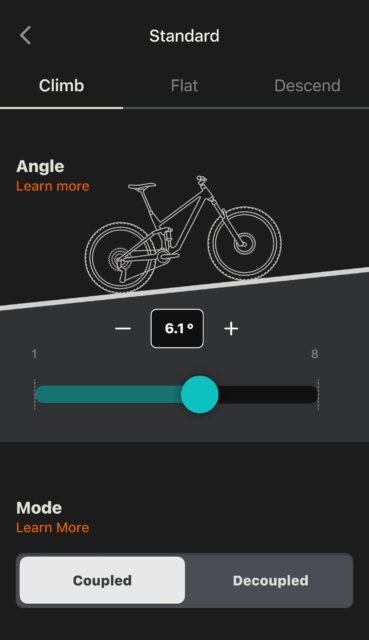
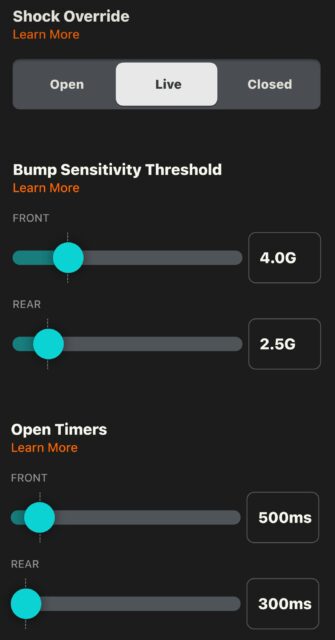
In addition to all of the tune settings, the app also serves many other purposes. Here’s a summary of the other app features:
- Displays the battery status of the shock and sensors
- Allows you to toggle whether the shock’s LED indicator lights up when a bump is detected (turning it off saves battery)
- Enable and disable “shake to wake” (turning it off requires you to push a physical button on the shock to wake it up, but prevents it from waking and burning battery while in transit)
- Displays service intervals and how many hours the shock has been ridden since its last service.
- Firmware updates can also be done via the app.
- Multiple bike profiles can be saved (with photos, if desired) in the “garage” in the app so that it’s easier to keep track of multiple Live-Valve-equipped bikes.
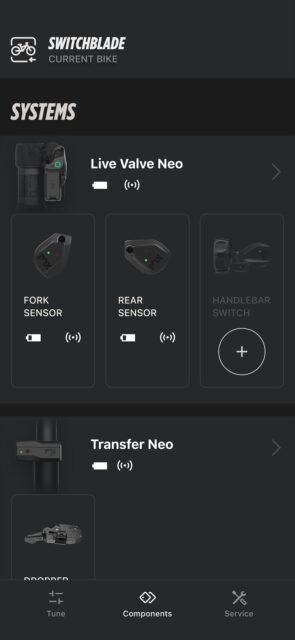
Availability & Compatibility
Live Valve Neo shocks don’t have a fork counterpart and don’t use a pedaling sensor (as with RockShox Flight Attendant), so there are very few limitations on what fork, crank, or other parts you want to run in conjunction with a Live Valve Neo shock. The only potential limiting factor is clearance for the sensors on the brake calipers in question. Fox says that all “modern” brakes from SRAM, Shimano, TRP, and Magura are compatible, so long as they use an inboard hose fitting; we can confirm that Hayes Dominion A4s / T4s work, too. Many Hope calipers have a bleed fitting in the same area as the sensor lands, but the sensors do bolt up to E4 and V4 calipers. We’ll need to do some testing and consult with Fox to see if the system works properly with the sensors rotated out a bit (as required to clear the bleed fittings), though.
The Live Valve Neo shocks won’t fit on every frame out there due to potential clearance issues between the shocks’ reservoir / control module and various frame components, but that’s true of most shocks to one degree or another; check with your frame manufacturer if you’re unsure. To their credit, Fox changes the reservoir length based on shock travel to improve clearance for shorter-travel implementations.
Fox is also opening up aftermarket sales of the Live Valve Neo shocks right away, in contrast to the approach RockShox took of launching Flight Attendant on complete bikes only.con
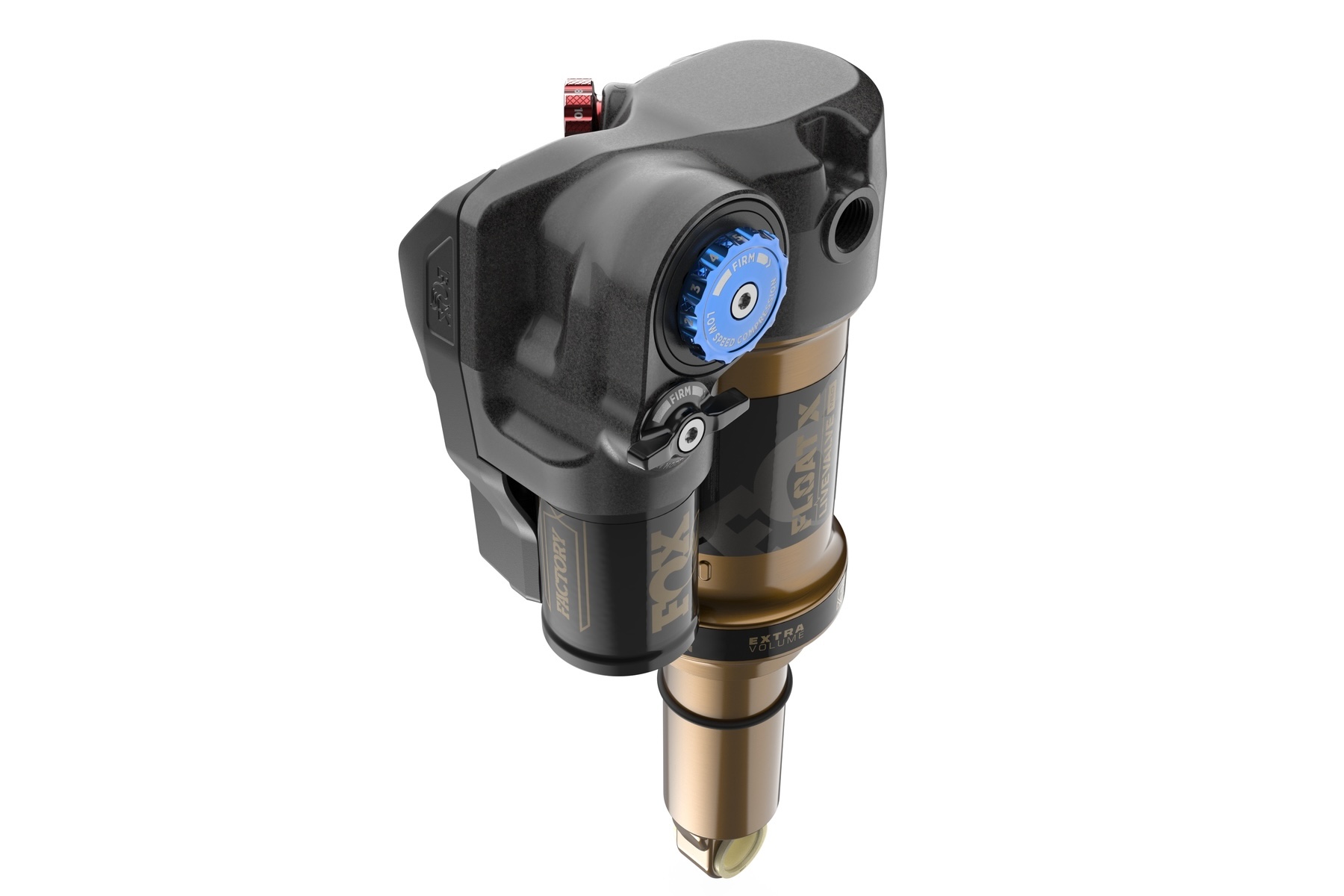
Some Questions / Things We’re Curious About
(1) First and foremost, how well does Live Valve Neo do what it’s supposed to do? Does it open the shock up reliably and on time when called upon? Are there any other quirks or issues? How is the battery life?
(2) Given their different approaches to accomplishing a similar goal, how does Live Valve Neo compare to RockShox Flight Attendant?
(3) Will we see more options for different Live Valve Neo shocks down the line (and maybe eventually forks)?
Bottom Line (For Now)
Electronically controlled suspension is clearly here to stay, and Fox’s Live Valve Neo system looks to be an interesting alternative to RockShox’s Flight Attendant, with Live Valve Neo having fewer required parts and greater cross-compatibility with a wider range of other components. We’ve already spent a lot of time on the DHX Live Valve Neo and will be rolling out a Full Review in the future — for now, BLISTER+ members and those with our Digital Access Pass can check out our thoughts so far in our Flash Review.
Flash Review: Our Initial On-Trail Impressions
BLISTER+ members and those who purchase our Digital Access Pass can check out the Flash Review below to read our initial on-trail impressions. Get our Digital Access Pass to view all our Flash Reviews and Deep Dives, or become a BLISTER+ member today to get access to that and a LOT more, including the best worldwide Outdoor Injury Insurance, exclusive deals and discounts on skis, personalized gear recommendations from us, and much more.
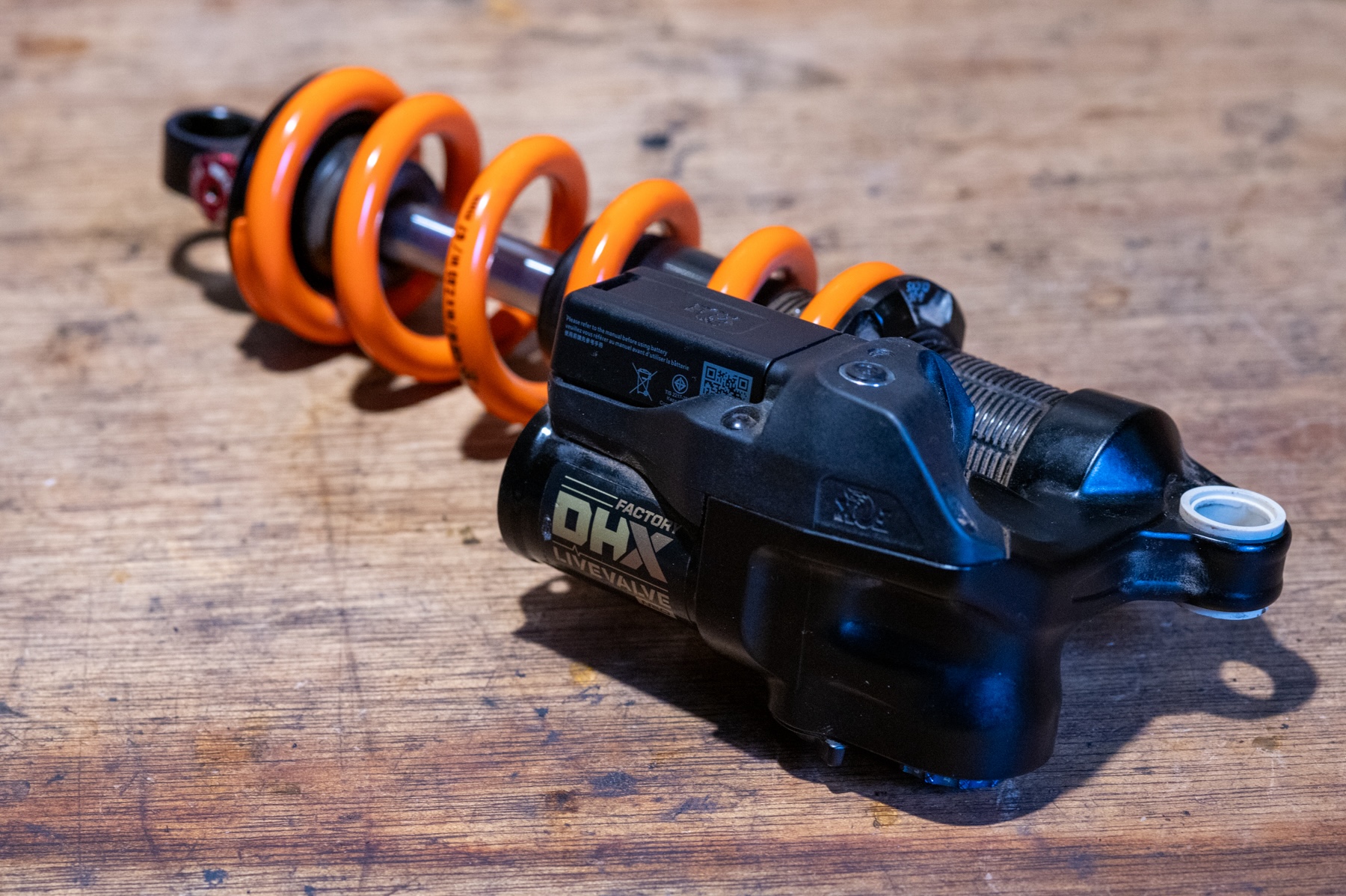
Flash Review — Fox DHX Live Valve Neo
We’ve been logging miles on Fox’s new DHX Live Valve Neo shock, and it’s been an interesting — and very highly customizable — new electronic suspension offering. Our Flash Review covers our early impressions.
Blister’s Flash Reviews and Deep Dives are accessible to those who purchase one of our paid subscriptions
To get our comprehensive Deep Dives and our initial, unfiltered reports on new gear, become a member and receive many other services, deals, and discounts.
If you’re already an active member, please log in.
(If you’re already logged in and a member in good standing and seeing this message in error, please refresh this page in your browser.)

Can you comment on whether the sensors can be made to fit on hayes dominion calipers and (unlikely, but I can dream) hope v4 calipers?
I’m guessing they dont fit well (or fox would probably list them) but maybe can be made to fit with some creativity?
Sadly, I believe that I can confirm this will not fit on a 2-piston XT rear brake — outboard hose fitting — which I ended up with as a warranty replacement a couple years back, when that was all Shimano could ship without a 3 week wait. Grrr.
Sydney these guys got it to work wtih Hope V4’s by flipping the sensor to the bottom bolt
https://thelostco.com/blogs/blog/fox-live-valve-neo-review?srsltid=AfmBOoo7QOu8gie5KU4TrOkRp480HpTzQ_4T_vja9L983TV4u9aMAple